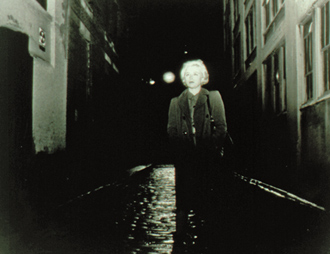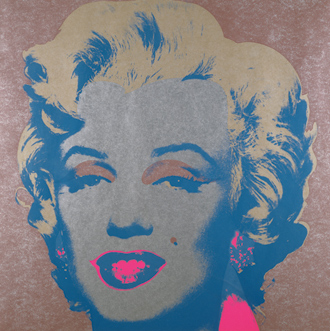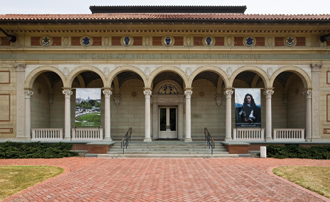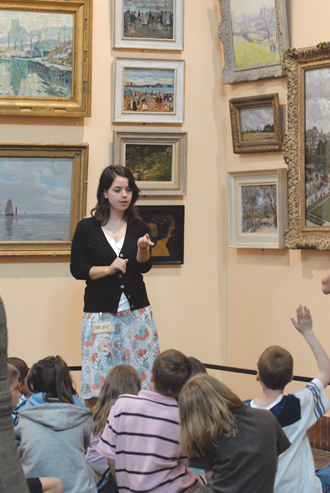Oberlin Alumni Magazine
Summer 2009 Vol. 104 No. 4
The Art
of the Matter
 Roy Lichtenstein (American, 1923-1997); Crying Girl, 1964; Silkscreen; Art Rental Collection Transfer via Art Museum Gift Fund, 1997.3
Roy Lichtenstein (American, 1923-1997); Crying Girl, 1964; Silkscreen; Art Rental Collection Transfer via Art Museum Gift Fund, 1997.3
 Cindy Sherman (American, b. 1954); Untitled Film Still #55 (Blonde in Alley), 1980; Gelatin silver print; Ellen H. Johnson Bequest, 1998.7.131
Cindy Sherman (American, b. 1954); Untitled Film Still #55 (Blonde in Alley), 1980; Gelatin silver print; Ellen H. Johnson Bequest, 1998.7.131
 Andy Warhol (American, 1928-1987); Marilyn Monroe, 1968; Color silkscreen on silver paper; Friends of Art Fund, 1969.19
Andy Warhol (American, 1928-1987); Marilyn Monroe, 1968; Color silkscreen on silver paper; Friends of Art Fund, 1969.19
 (photo by Ralph Lieberman)
(photo by Ralph Lieberman)
Combining its mighty collection with curricula across disciplines, the Allen Memorial Art Museum shows what it means to be a teaching museum.
Three blondes lie on a table in the Allen Memorial Art Museum’s Wolfgang Stechow Print Study Room, surrounded by a small group of Oberlin students with thoughtful faces.
Roy Lichtenstein’s print Crying Girl is propped on one easel. On another easel is an image from photographer Cindy Sherman’s Untitled Film Stills series in which she uses herself as a model in poses and scenes that suggest iconic movie moments—here, she is a lone woman on a starkly lit street. In between them, Andy Warhol’s silkscreened Marilyn Monroe lies naked of protective glass or framing on the table, her mouth an eruption of pink, her hair a golden cloud.
"Here, Marilyn is like the medieval images of saints," says Amanda Shubert ’10, an Oberlin English major and one of the Allen’s six student docents. "She doesn’t look like a real person. She’s there to represent an idea."
"She’s offering [a type of] power to the viewer," suggests one of the students in the class, which is called Power Eroticized. "In this case, power is sex."
This private viewing in the Print Study Room is the culmination of a customized class tour organized by Colette Crossman, the Allen’s curator of academic programs, in consultation with Visiting Assistant Professor of English Piia Mustamaki. The tour began downstairs in front of Hendrick ter Brugghen’s St. Sebastian Tended by Irene—a work that graced the cover of a recent book about European masterpieces in American collections—then wound its way through the other downstairs galleries and upstairs to the Print Study Room. Crossman selected the images as a visual complement to Mustamaki’s class. The students have been reading a variety of plays that deal with the sexualization of power, so Crossman selected images from the Allen’s 13,000 works that encouraged further exploration of the themes and ideas that come up in the classroom.
In the hushed space of the Print Study Room, the students become voluble about the artwork. Their discussion trails down the stairs as they exit with Mustamaki.
"There’s something so vital about this firsthand encounter with original works of art," Crossman says. "Students get excited when they have the opportunity to look at these things up close, especially in this space, which is a working storage area that’s not usually open to the public."
The Allen has been a rich resource for faculty and students ever since its founding in 1917. Thanks to the ongoing generosity of alumni and other benefactors, it is recognized as one of the top five college and university art museums in the United States. Museum director Stephanie Wiles calls the collection "encyclopedic"—strong in a wide variety of areas including European and American paintings and sculpture from the 14th century to the present, as well as important holdings of Asian, African, and ancient art. Every year, teaching exhibitions drawn from collections at the Allen and beyond are created on themes as varied as "Aux Barricades! French Protest Posters from May ’68," designed to support a French course commemorating a spring of student unrest in the French capital, and "‘To Make Things Visible’: Art in the Shadow of World War I," organized to accompany an international conference on World War I and its aftermath sponsored by the history department.
"We have an endless stream of ideas," Wiles says, "and they all come directly out of having such an incredible group of works to organize exhibits around."
In the last few years, the museum has intensified its efforts to enhance the academic mission of Oberlin College by integrating this collection into teaching, learning, and research across both the College of Arts and Sciences and the Conservatory of Music. A key step was the 2007 reinstatement of the Office of Academic Programs after a six-year gap and the hiring of Crossman, who works closely with faculty to arrange curricular encounters between students and the art. Then, in the fall of 2008, the Allen received a $1.25 million challenge grant from the Andrew W. Mellon Foundation. The grant, together with the $750,000 match to be raised over the next three years, will provide a permanent endowment for the museum’s Office of Academic Programs.
Since the 1990s, the Mellon Foundation has encouraged a national dialog about how college and university museums serve curricula through their collections. "There’s an ongoing conversation about the importance of visual literacy in a liberal arts education," Crossman says. "It’s essential that students know how to read, analyze, and interpret visual material, and the museum is part of a wider movement to build that skill into the college curriculum."
The combination of Crossman’s hiring and this new support from the Mellon Foundation has resulted in a surge of academic engagement at the Allen. In the 2008 school year, there were 184 class visits to the museum, including 76 in the Print Study Room. Student visits to the museum during classes totaled 3,940, a remarkable feat for a student body of around 2,800, suggesting that many students are returning to the museum in multiple classes. Fifty-five faculty members from 25 departments brought classes to the Allen, including first-time visits from computer science, comparative American studies, environmental studies, mathematics, and neuroscience. Many of these grew directly out of pedagogical workshops held by Crossman to train faculty in how to teach with original works of art. As a further extension of faculty development, the museum has launched new Andrew W. Mellon Foundation AMAM Curriculum Development grants that will allow four professors to revise fall 2009 classes in order to integrate more vigorously academics with the museum’s collection.
Students themselves have become more involved in bridging the gap between the classroom and the museum. One of Crossman’s innovations is the Docent Liaison Program, in which students trained as docents for K-12 and other public tours (see sidebar) work with Crossman to organize and lead museum classes for Oberlin College courses. Like Amanda Shubert, these are students with majors outside of art history, so they already have ties in academic departments that might not naturally look to the museum as a resource.
Neuroscience/English major Alex Michel ’09 took the docent training class because she thought it sounded like fun, and then became a docent liaison who helped develop and lead a tour called "The Brain is Wider than the Sky" for a freshman seminar in neuroscience. Her tour focused on the way artists seemed to understand the connections between vision and the brain long before science did.
"Cézanne said the eye doesn’t work like a camera," says Michel, who uses Cézanne’s Viaduct at l'Estaque in the Allen’s sculpture court as an example. "That was a popular idea back then—people saw the eye as a machine that captured images perfectly. Now we know that it takes a tremendous amount of complicated cognition to make sense of what the eye sees. Cézanne anticipated that with this idea of painting that encourages interpretation."
The four professors with curriculum development grants spent much of the summer studying the collection and selecting artwork for fall classes that will visit the museum multiple times during the semester. Having observed the tours Crossman previously arranged for their students, they saw the museum collection’s potential to provide even greater primary source materials for their subjects.
"Eighteenth-century Britain seems so foreign to students that it helps if they can picture the period," says Laura Baudot, an assistant professor of English who’s teaching a fall course called Wits, Rakes, Madmen and Jane. Among other works, she’s making good use of the museum’s William Hogarth prints that show the moral and material decline of woefully freethinking and libertine young men. "When they see the funny satirical images of the 18th century—the high wigs, the big dresses, the men in tights—it dispels their sense of the formality of the period. They also get a sense of the didactic nature of the satire genre."
Emer O’Dwyer—a grant recipient who is building extra museum time into a class called Japan From Earliest Times to 1868—finds the Allen’s collection particularly helpful in providing her students a very direct link to the culture they’re studying. Most can’t read the Japanese texts from the period without translation, but they can more easily "read" the artwork. They will study ukiyo-e prints that depict enduring narratives in Japanese culture, including scenes from the 12th-century Genpei Wars—with heroes as archetypal as Odysseus and Achilles are in western culture. O’Dwyer, an assistant professor of history and East Asian studies, will also use the collection to introduce her students to the lives of women during this period. Aside from the grousing of male writers about unfit wives or inept mothers, the written material doesn’t address this subject. However, many of the Allen’s Japanese prints show women engaged in daily activities.
Interestingly, the Allen’s collection is one of the things that attracted O’Dwyer—on the faculty since 2007—to Oberlin. When she came to the college for an interview, she made a point of visiting the Allen. "I hardly had time to tie my shoes, but I really wanted to see it," she says. "I was overwhelmed by the depth of the collection in Asian art and the exquisite nature of each piece. That was in my mind when I accepted the job and starting preparing courses."
Kris Ohlson is a freelance writer in Cleveland.
The Allen Memorial Art Museum
is a Community Resource

The Allen Memorial Art Museum is a community resource in the very broadest sense, reaching beyond the campus to a regional and national public.
Each year, schoolteachers from five counties bring students ranging from kindergarten through high school to the museum. There, Oberlin student docents trained by Jason Trimmer, the Allen’s curator of education, lead them through the collection—either a "highlights" tour or one geared specifically to their curricular goals.
"Almost 75 percent have never been to a museum before," Trimmer says. "They’re amazed that they can come in here and see a Picasso or a Monet for free."
The Allen’s outreach to the schools begins long before the tours, though. Supported by an Ohio Arts Council Grant, Trimmer holds workshops for local teachers to help them figure out how to best use the collection, and prepares teacher resource sheets about specific works of art that support Ohio’s educational benchmarks. According to Allen director Stephanie Wiles, Trimmer’s curricular outreach to K-12 students often dovetails nicely with Colette Crossman’s work with Oberlin students and faculty.
The Allen’s student docents interact with other audiences, too, including senior citizens groups and casual visitors. Recently, some of them have been working on a podcast series about current museum projects, exhibitions, and works in the collection that can be downloaded and heard by anyone—from people walking into the museum to people halfway around the globe.
"The museum is so wonderful and the collections are so great that they should be accessible to everyone," says Alex Michel ’09, a docent who’s helping Trimmer produce the podcasts.
